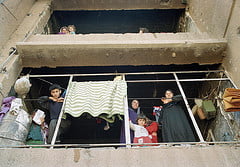Ankawa, a neighborhood on the north side of Erbil, in northern Iraq, does not live and breathe like a refugee camp or place of suffering. It is a cluster of streets dotted with Chaldean churches, cafebars, and liquor stores in an otherwise Kurdish, Muslim-dominated district. The neighborhood appears more like a colorful safe haven not only for free-thinking Iraqis but also for foreign aid workers.
However, this oasis now hosts as many as 10,000 displaced ethnic minorities who have fled central Iraq, and, like many others, this host community is now being overburdened with the cost of playing good neighbor. The latest waves of Christian minorities have come after the withdrawal of the U.S. coalition. The last round arrived after a fiery attack on a Baghdad church in October 2010. And they are making Ankawa a symbol for the Middle East’s invisible refugee crises, the migration of peoples from homes to friends homes out of the eye of Western press and often off the beneficiary lists of aid agencies.
Kurdish authorities have spoken publically that the region welcomes minorities seeking refuge, including those who are Christians or other minorities. Unlike displaced families who arrive at formal camps or government offices, however, many of these families are staying with relatives or friends, off the books. The great advantage these relationships provide at the beginning of their flight turns upside down when their host families become overburdened financially. Often this after shock happens well after government and aid agencies have already reduced focus on the region.
While many governments, donors, and aid agencies have moved on from responding to crises like that of Iraq, troubles for local displaced families remain. As in the case of Ankawa, many host communities absorb the shock during the height of the crisis – relieving the burden on governments and donors – only to have their homes become overloaded and their pocketbooks, as well as those of their displaced guests, turn empty well after the crisis has climaxed in the media. The tragic flight of minorities from central Iraq to the north has not only been a larger crisis than anyone anticipated. It has also created a new, secondary crisis for host communities that governments, donors, and aid agencies are only beginning to figure out how to address.
